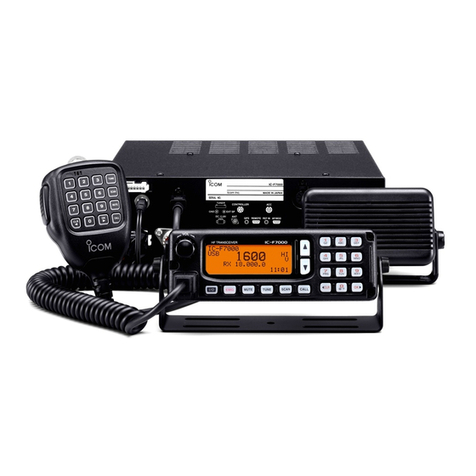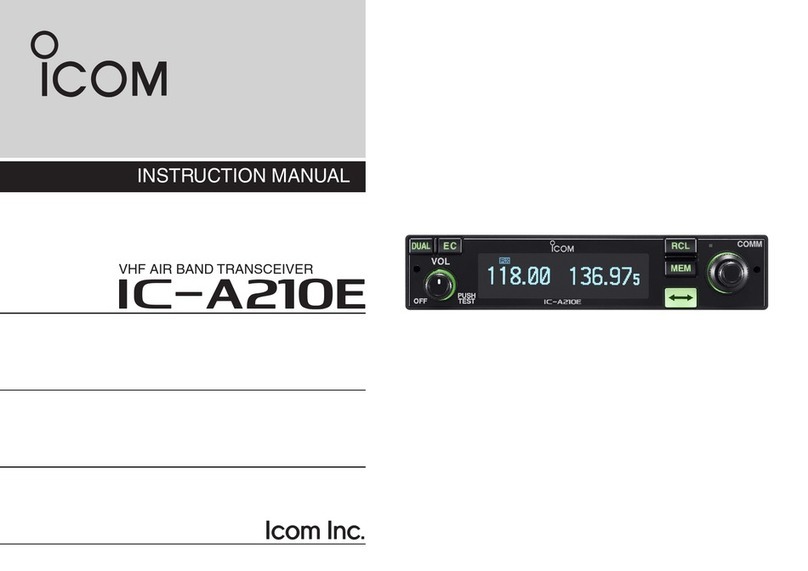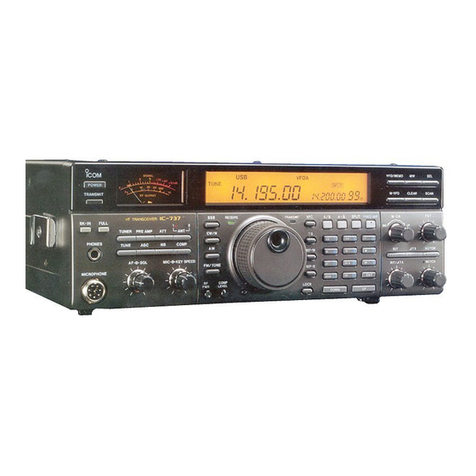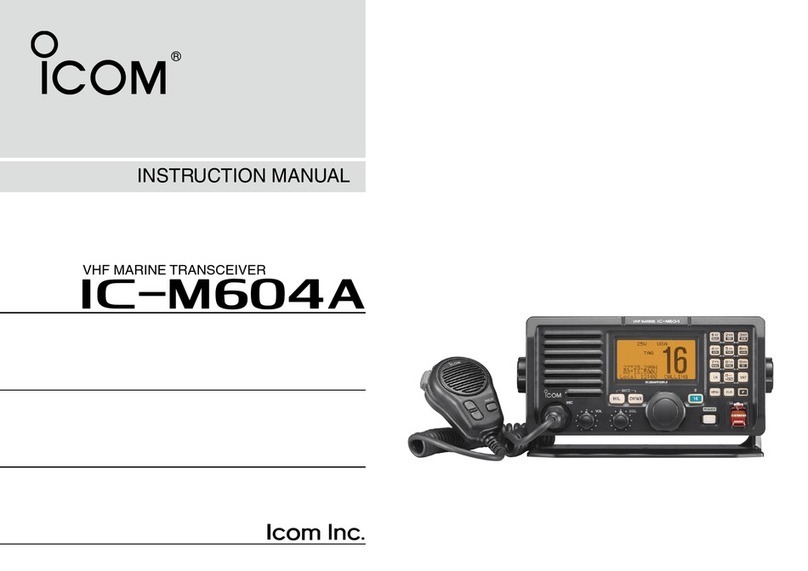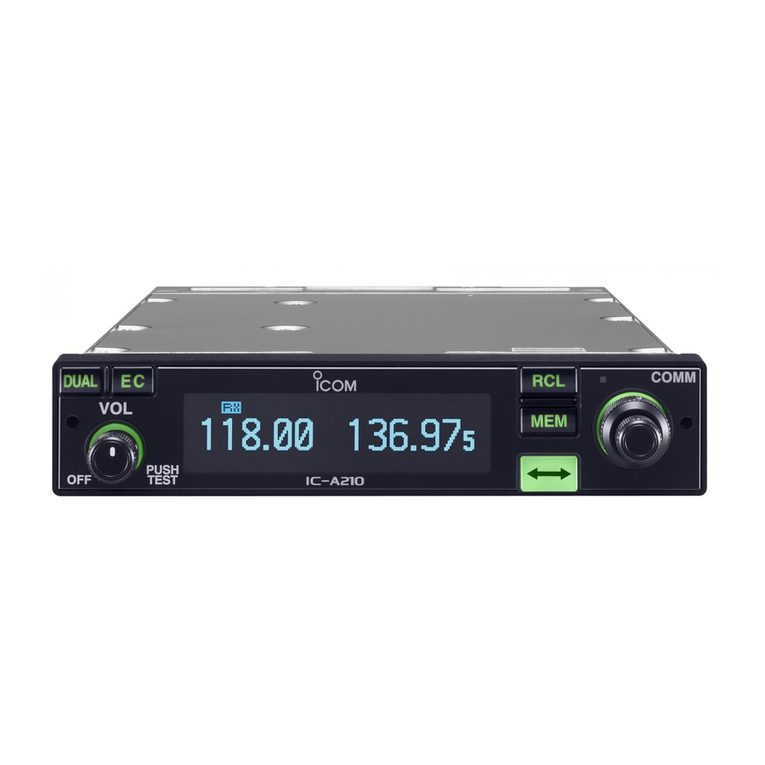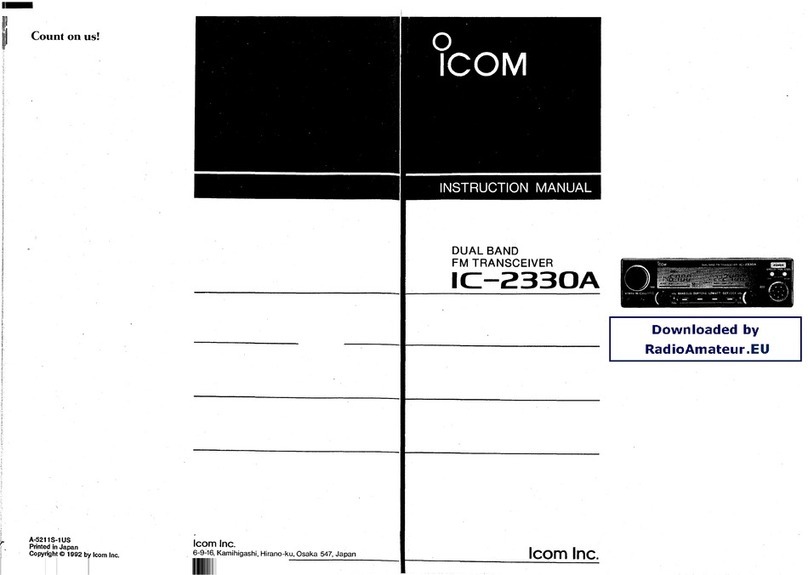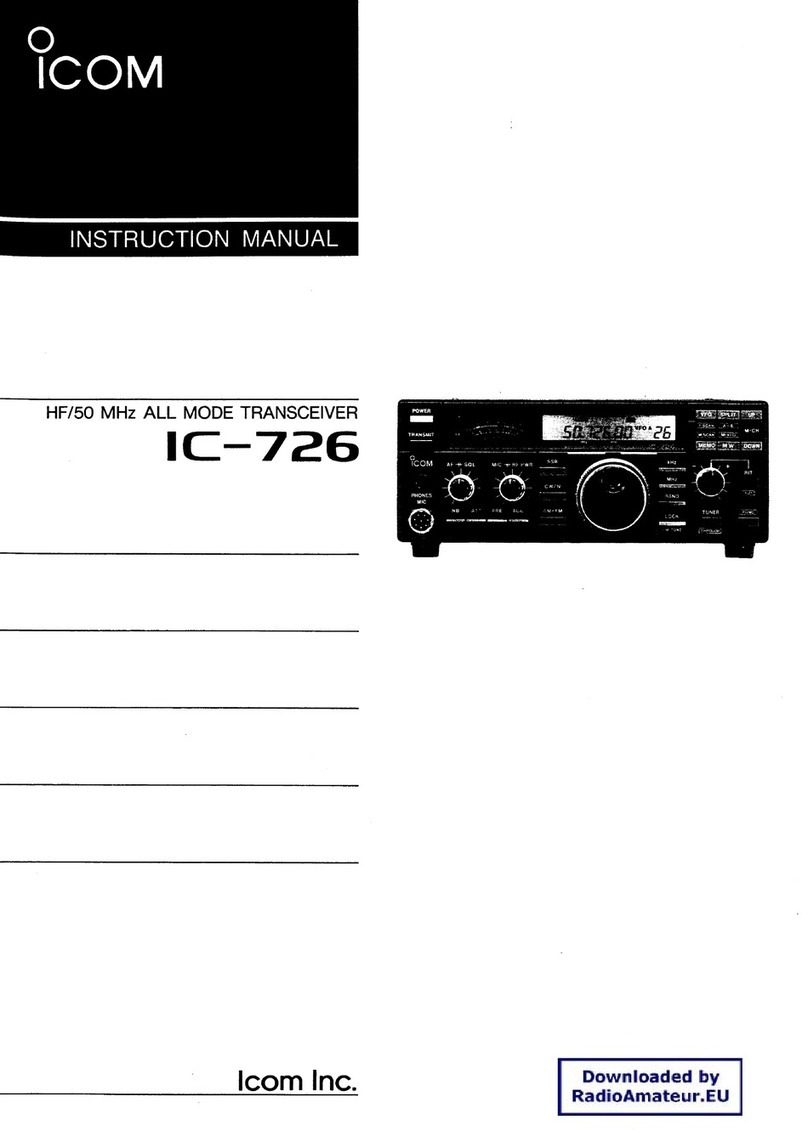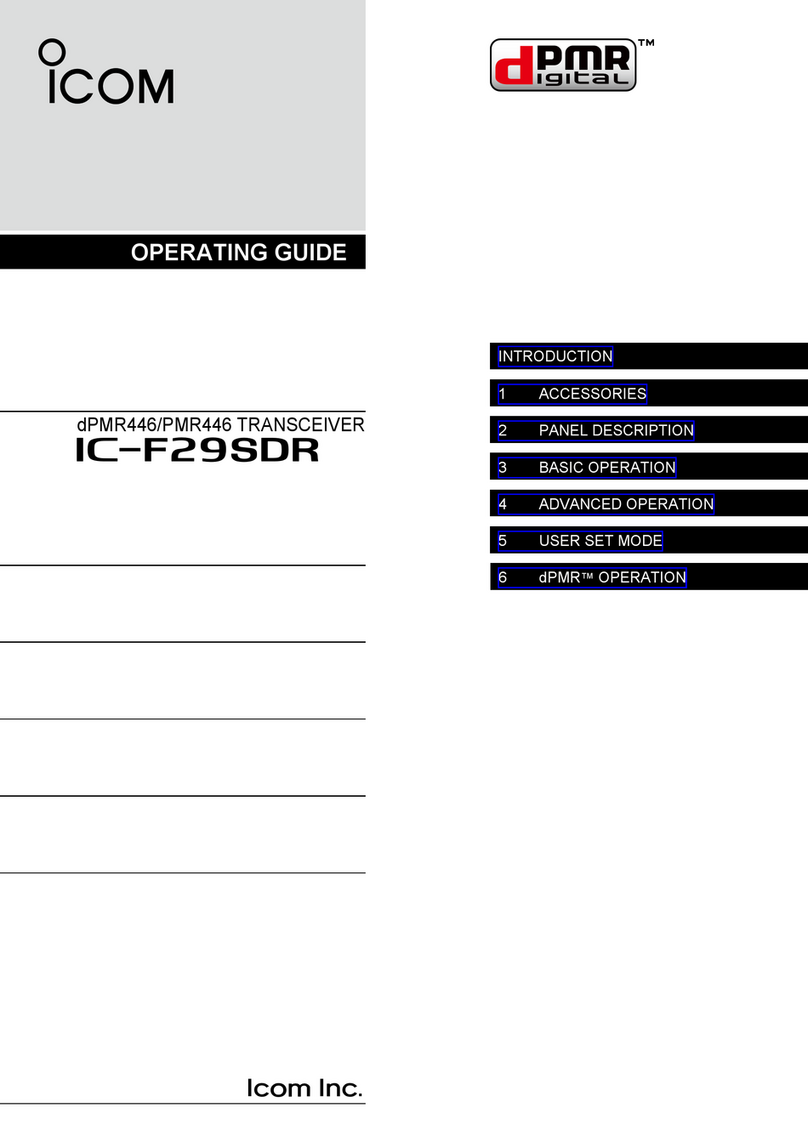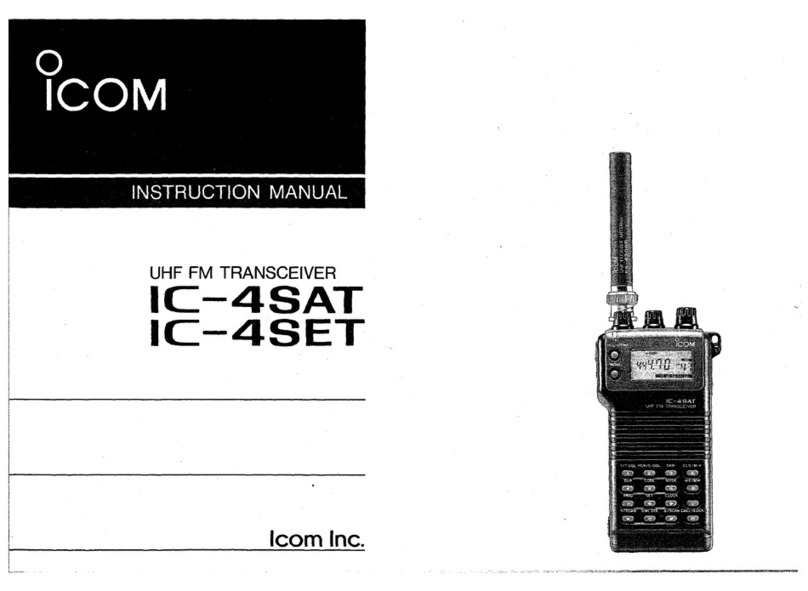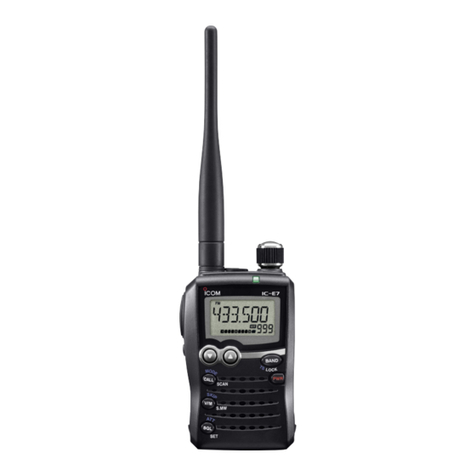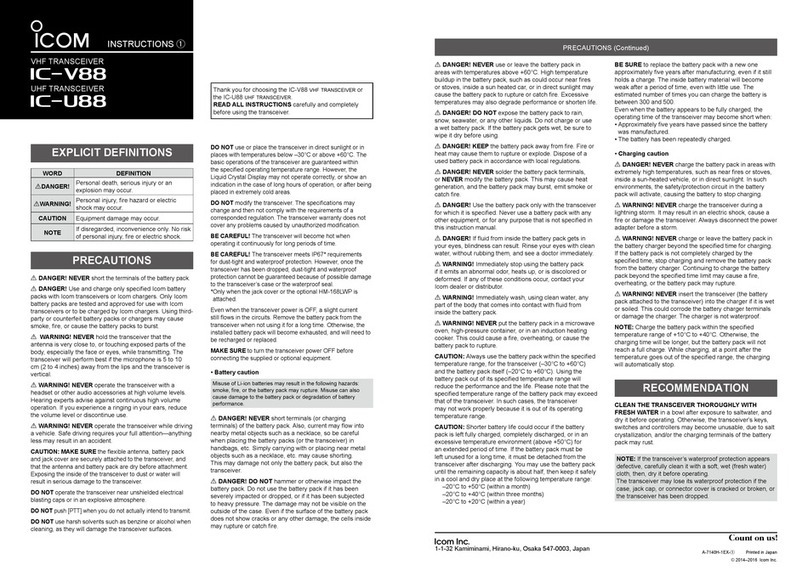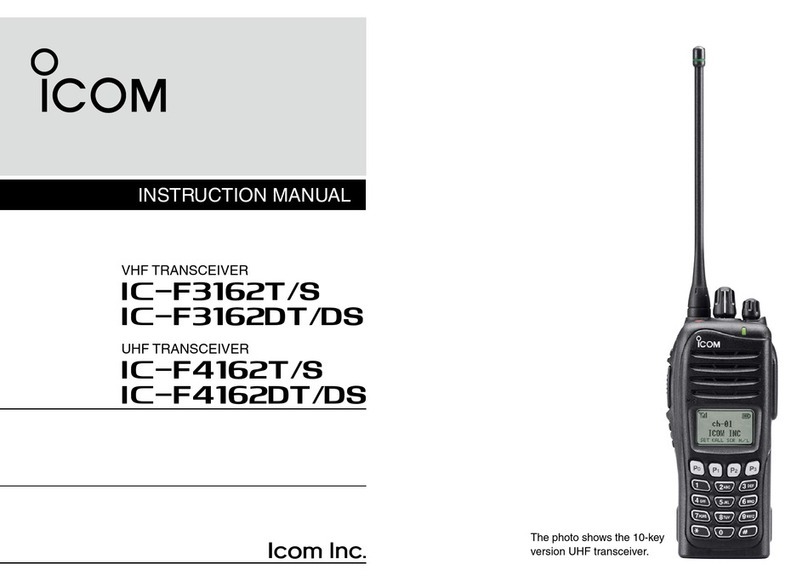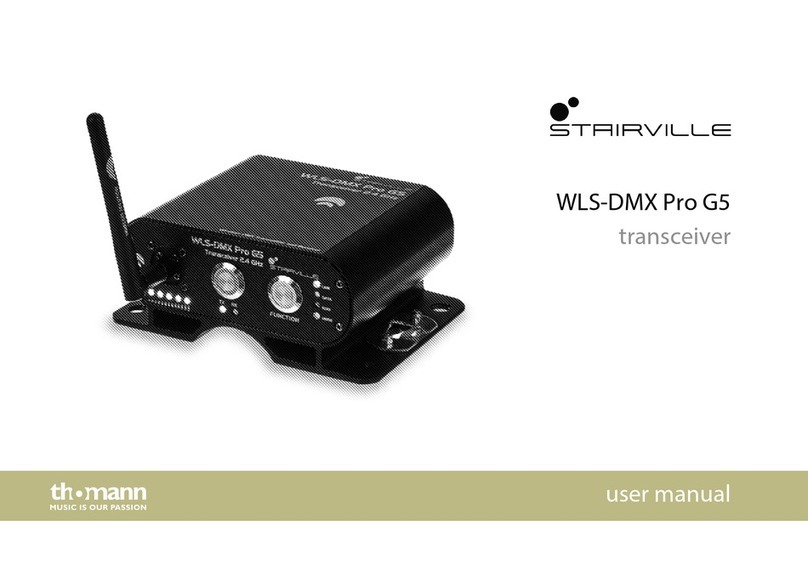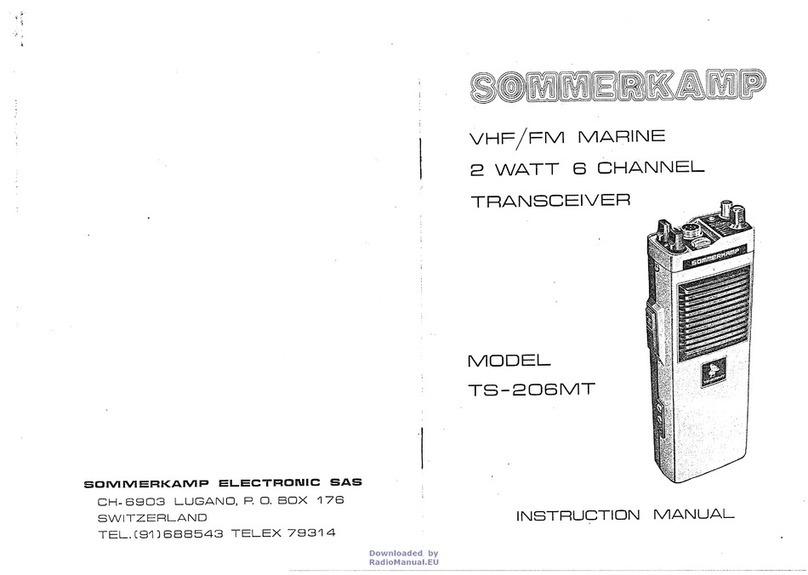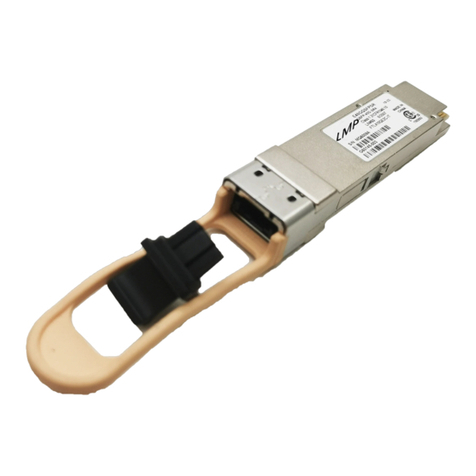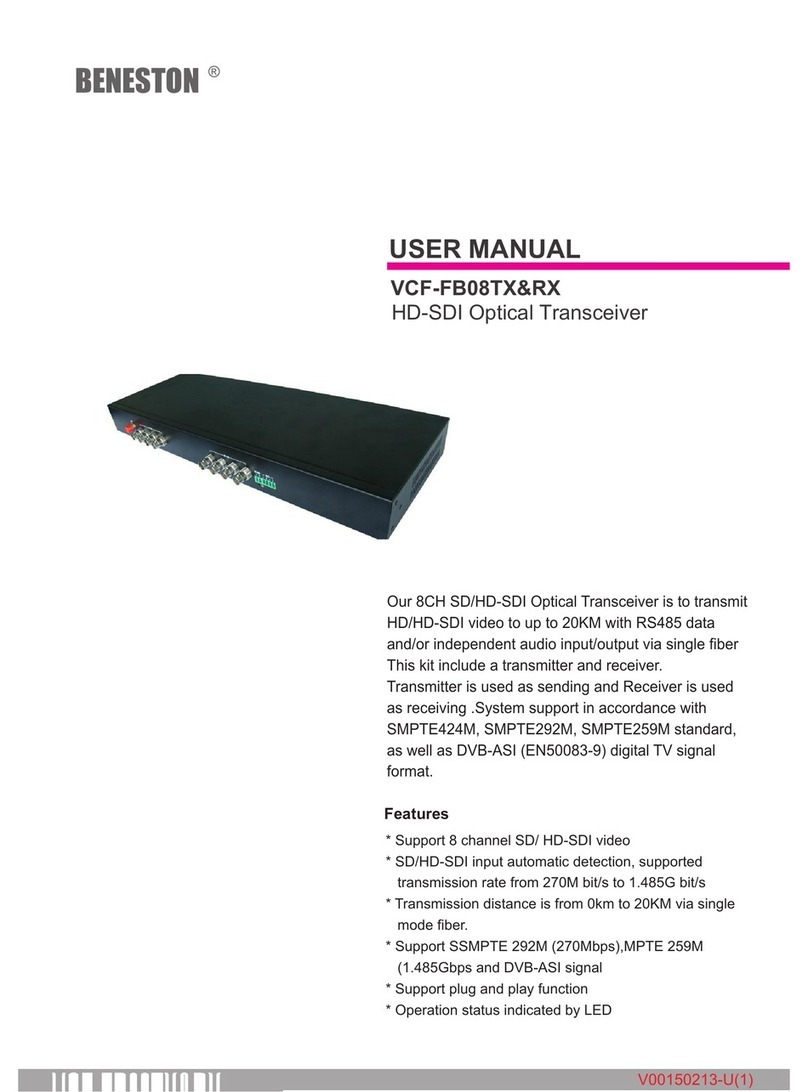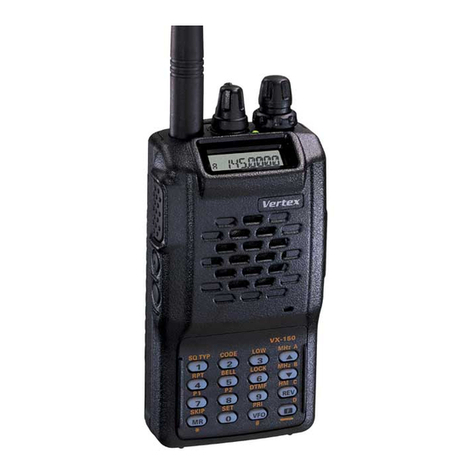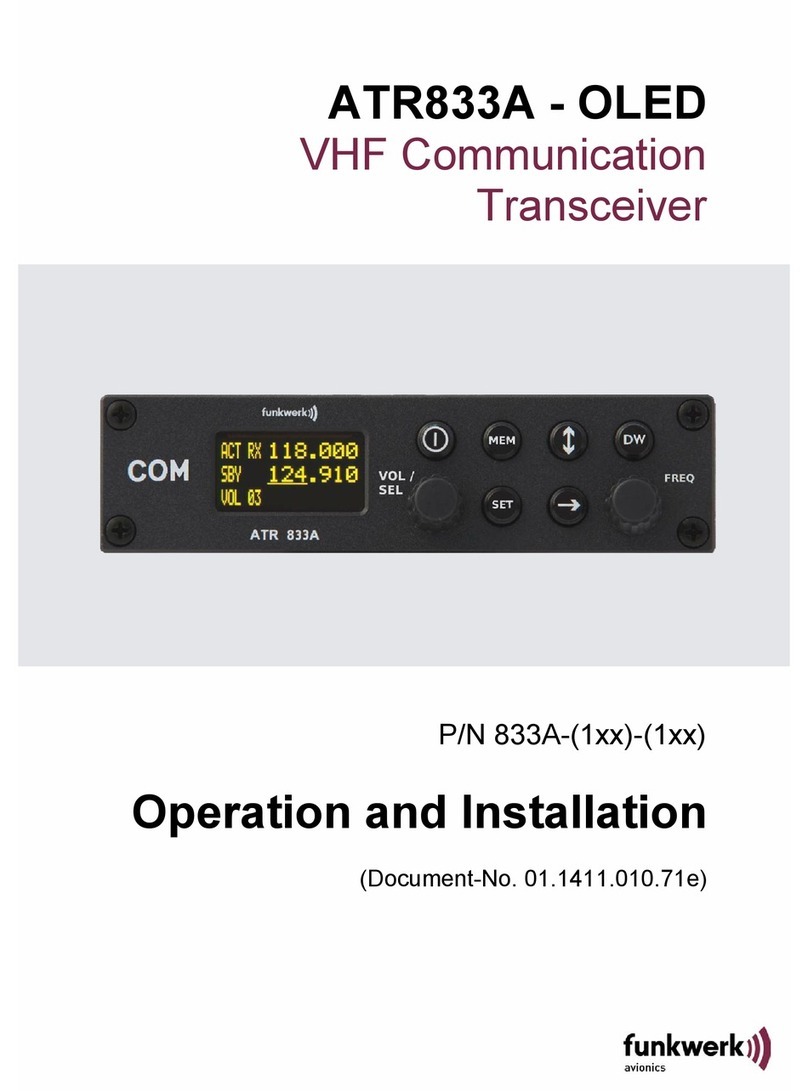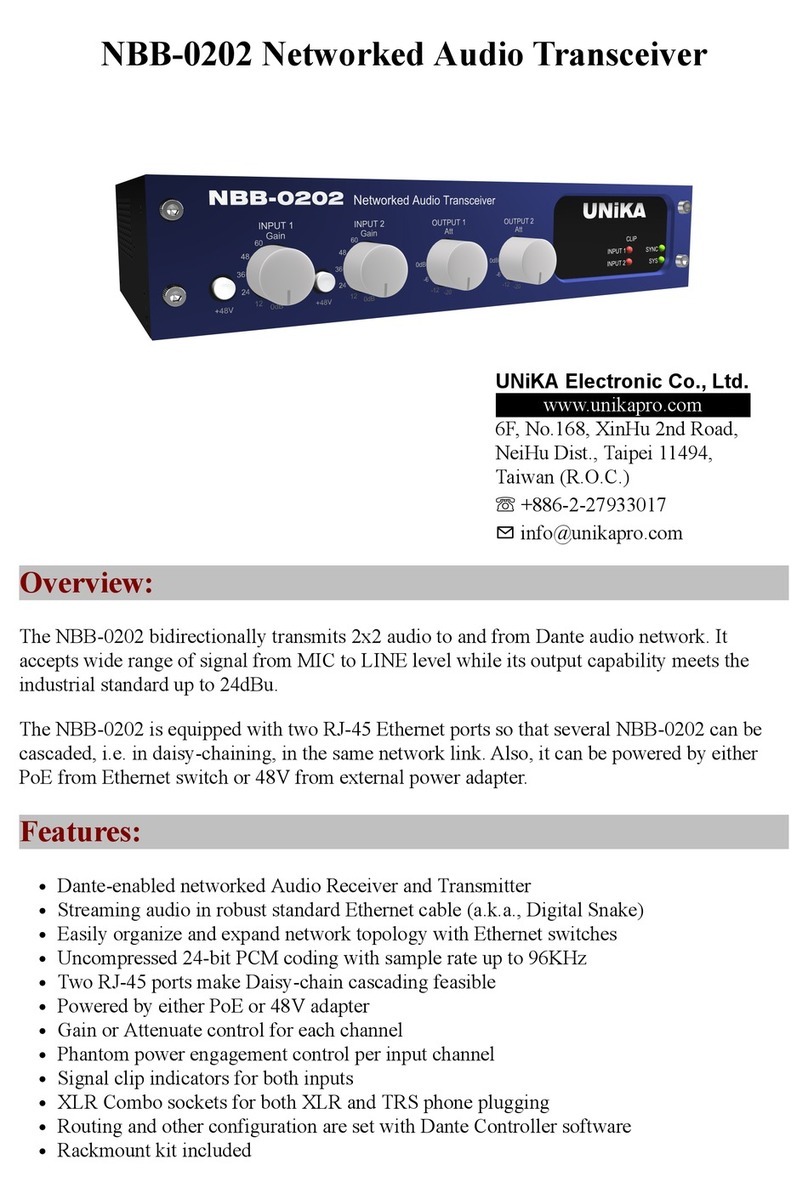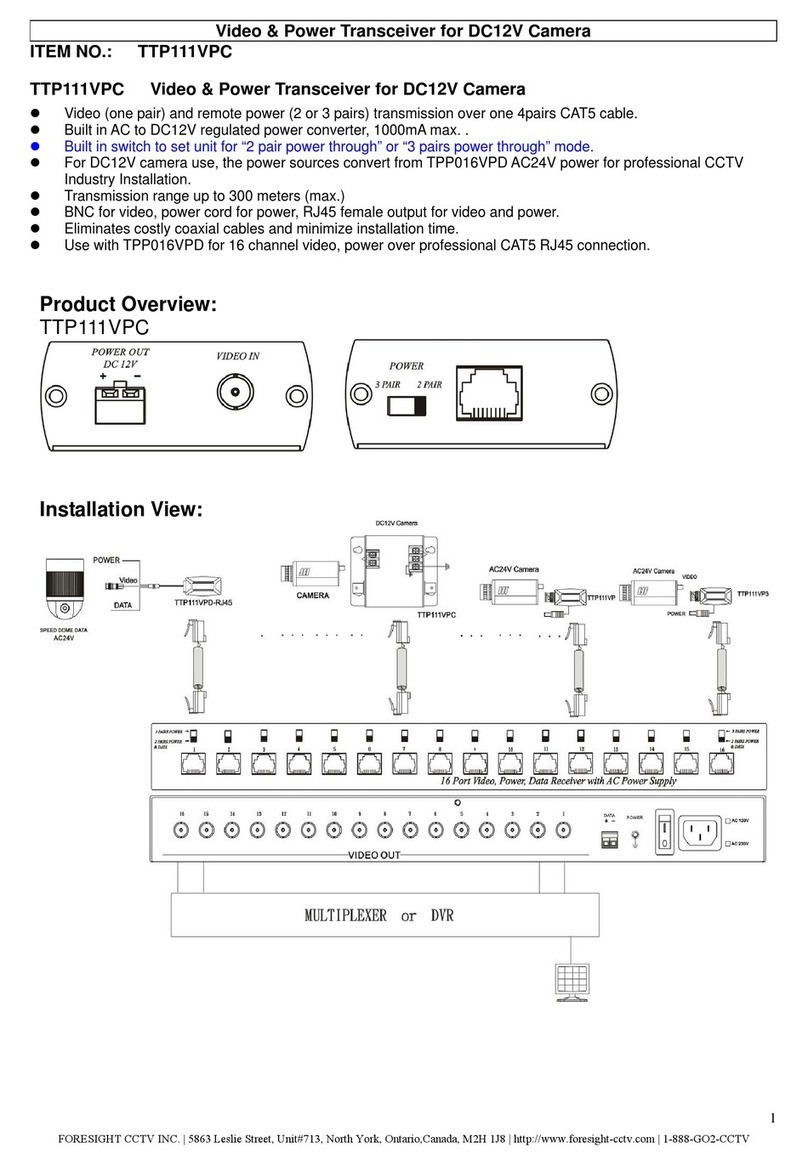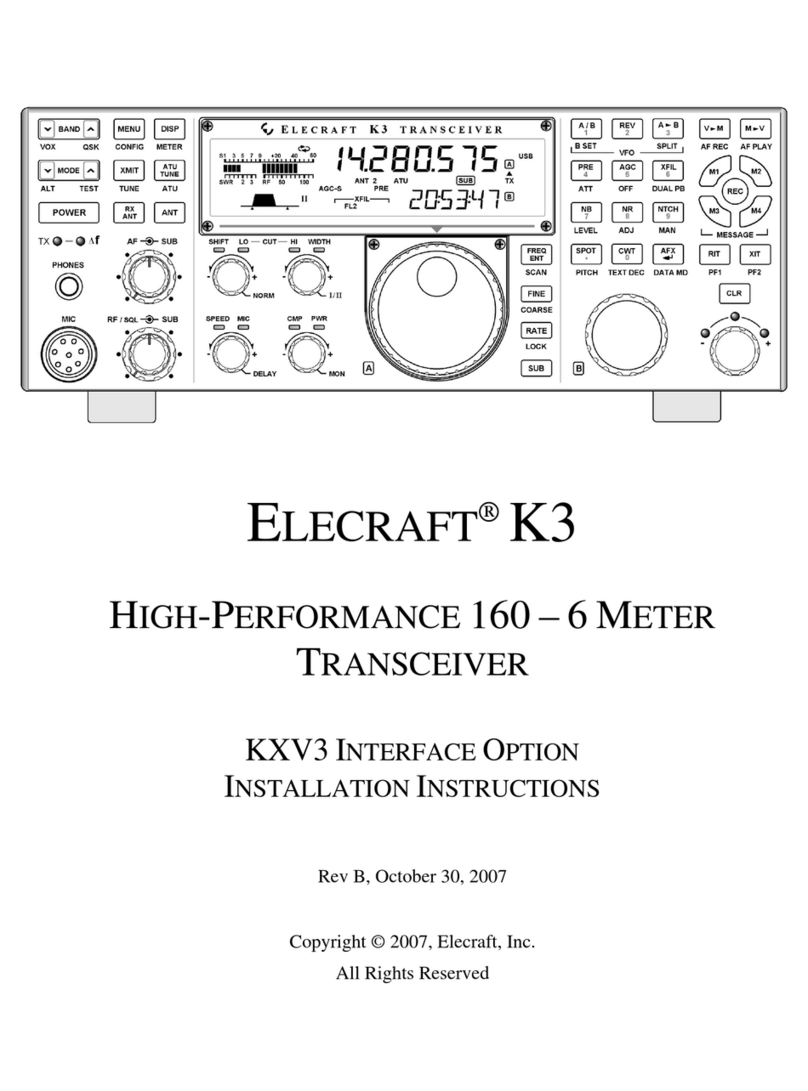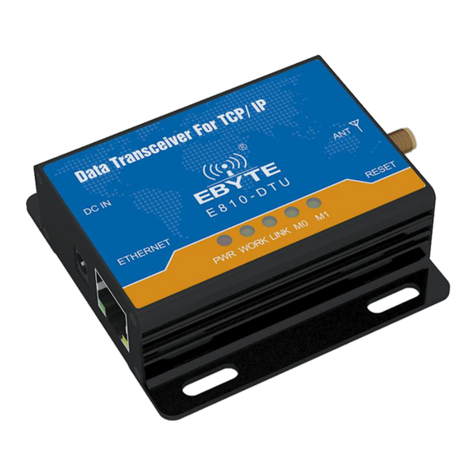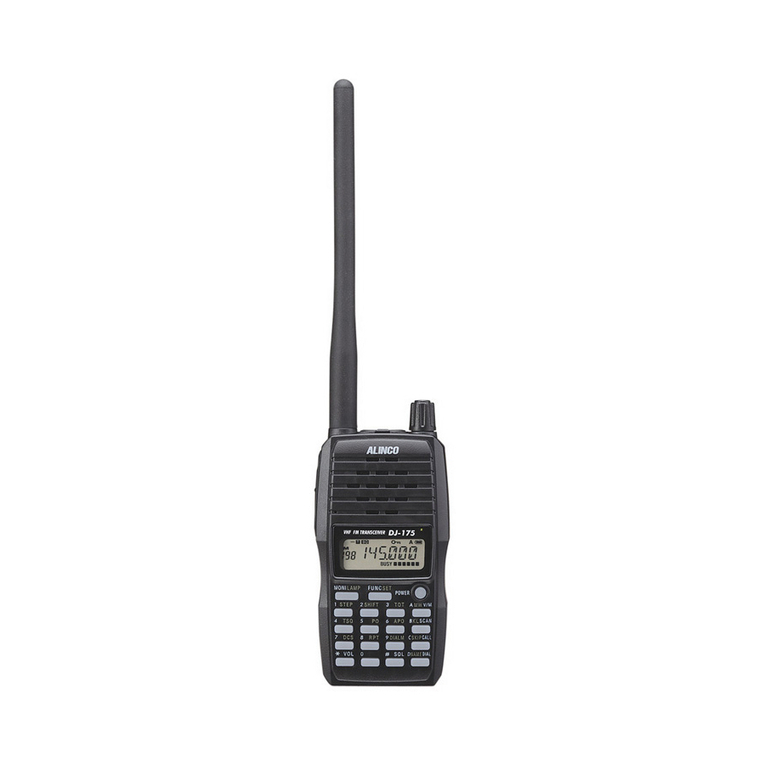Icom IC-V8000 User manual

INSTRUCTION MANUAL
iV8000
VHF FM TRANSCEIVER
This device complies with Part 15 of the FCC rules. Operation is sub-
ject to the following two conditions: (1) This device may not cause
harmful interference, and (2) this device must accept any interference
received, including interference that may cause undesired operation.

FOREWORD
Thank you for purchasing this Icom product. The IC-V8000
VHF FM TRANSCEIVER
is designed and built with Icom’s supe-
rior technology and craftsmanship. With proper care, this prod-
uct should provide you with years of trouble-free operation.
We understand making you have a choice of many different
radios in the market place. I want to take a couple of mo-
ments of your time to thank you for making your IC-V8000
your radio of choice, and hope you agree with ICOM’s philos-
ophy of “technology first.” Many hours of research and devel-
opment went into the design of your IC-V8000.
FEATURES
❍75 W* of high transmit output power
(except Taiwan version)
❍Front mounted speaker for clear readability
❍Tone squelch, DTCS squelch standard
❍Dual color (amber & green) LCD backlight
❍Remote control microphone available
(optional for some versions)
❍Optional DTMF decoder
IMPORTANT
READ ALL INSTRUCTIONS carefully and completely
before using the transceiver.
SAVE THIS INSTRUCTION MANUAL— This in-
struction manual contains important operating instructions for
the IC-V8000.
EXPLICIT DEFINITIONS
i
WORD DEFINITION
RWARNING!
CAUTION
NOTE
Personal injury, fire hazard or electric shock
may occur.
Equipment damage may occur.
Recommended for optimum use. No risk of
personal injury, fire or electric shock.
Icom, Icom Inc. and the are registered trademarks of Icom In-
corporated (Japan) in the United States, the United Kingdom, Ger-
many, France, Spain, Russia and/or other countries.

ii
CAUTIONS
RWARNING RF EXPOSURE! This device emits
Radio Frequency (RF) energy. Extreme caution should be ob-
served when operating this device. If you have any questions re-
garding RF exposure and safety standards please refer to the
Federal Communications Commission Office of Engineering and
Technology’s report on Evaluating Compliance with FCC Guide-
lines for Human Radio frequency Electromagnetic Fields (OET
Bulletin 65)
RWARNING! NEVER connect the transceiver to an AC
outlet. This may pose a fire hazard or result in an electric shock.
RWARNING! NEVER operate the transceiver while dri-
ving a vehicle. Safe driving requires your full attention—anything
less may result in an accident.
NEVER connect the transceiver to a power source of more
than 16 V DC. This will ruin the transceiver.
NEVER connect the transceiver to a power source using re-
verse polarity. This will ruin the transceiver.
NEVER cut the DC power cable between the DC plug and
fuse holder. If an incorrect connection is made after cutting, the
transceiver may be damaged.
NEVER place the transceiver where normal operation of the
vehicle may be hindered or where it could cause bodily injury.
NEVER let objects impede the operation of the cooling fan on
the rear panel.
DO NOT push the PTT when not actually desiring to trans-
mit.
DO NOT allow children to play with any radio equipment con-
taining a transmitter.
During mobile operation, DO NOT operate the transceiver
without running the vehicle’s engine. When the transceiver’s
power is ON and your vehicle’s engine is OFF, the vehicle’s bat-
tery will soon become exhausted.
BE CAREFUL! The transceiver will become hot when op-
erating it continuously for long periods.
AVOID using or placing the transceiver in direct sunlight or in
areas with temperatures below –10°C (+14˚F) or above +60°C
(+140˚F).
AVOID the use of chemical agents such as benzine or alcohol
when cleaning, as they can damage the transceiver’s surfaces.
USE Icom microphones only (supplied or optional). Other man-
ufacturer’s microphones have different pin assignments and may
damage the transceiver if attached.

■Front panel
qPOWER SWITCH [PWR]
Turns power ON and OFF when pushed for 1 sec.
wMEMORY/CALL•PRIORITY SWITCH [M/CALL(PRIO)]
(p. 00)
➥Push to selects and toggles memory, call and weather
channel* mode.
*Weather channels available for USA versions only.
➥Starts priority scan when pushed for 1 sec.
eMICROPHONE CONNECTOR
Connects the supplied microphone. (p. 00)
rSQUELCH CONTROL [SQL]
Varies the squelch level. (p. 00)
• The RF attenuator activates and increases the attenuation when
rotated clockwise to the center position and further.
tVOLUME CONTROL [VOL]
Adjusts the audio level. (p. 00)
OPT
BANK
V/MHz
SCAN
LOW
DUP
MONI
ANM
SET
LOCK
PWR
S.MW
MW
T-SCAN
TONE
PRIO
M/CALL
t
Function display (p. 00)
q
w
e
ryuioSpeaker
!0!1!2!3
1
PANEL DESCRIPTION
1
2
3
4
5
6
7
8
9
10
11
12
13
14
15
16
17
18
19
20
21
1

2
1
PANEL DESCRIPTION
1
2
3
4
5
6
7
8
9
10
11
12
13
14
15
16
17
18
19
20
21
yBANK•OPTION SWITCH [BANK(OPT)]
➥Selects memory memory bank when pushed. (p. 00)
➥Push for 1 sec. to turn the DTMF decoder ON and OFF
when the optional UT-108 is installed. (p. 00)
uSET•LOCK SWITCH [SET(LOCK)]
➥Selects set mode when pushed.
➥Switches the lock function ON and OFF when pushed
for 1 sec. (p. 14)
iTUNING DIAL [DIAL]
Selects the memory channel (p. 00), call channel (pgs. 00,
00, 00), the contents of the set mode display and the
scanning direction (p. 00).
oMEMORY WRITE SWITCH [MW(S.MW)]
➥Enter to memory edit mode when pushed. (p. 00)
➥Program into the selected memory channel when
pushed for 1 sec. (p. 00)
•Continue to hold the switch to increment the memory channel
automatically.
!0 MONITOR•CHANNEL NAME SWITCH [MONI(ANM)]
➥Push to switch the monitor function ON and OFF. (p. 00)
➥Push for 1 sec. to toggle the frequency indication and
channel name indication. (p. 00)
!1 OUTPUT POWER SWITCH [LOW(DUP)]
➥Each push changes the output power selection. (p. 00)
➥Select DUP–, DUP+ and simplex operation when
pushed for 1 sec. (p. 00)
!2 TONE/TONE SCAN SWITCH [TONE(T-SCAN)]
➥Each push selects a tone function. (p. 00)
•Tone encoder, pocket beep, tone squelch or tone function
OFF can be selected.
➥Push for 1 sec. to start/stop the tone scan function.
(p. 00)
!3 VFO/MHz TUNING•SCAN SWITCH [V/MHz(SCAN)]
➥Selects and toggles VFO mode and 1 MHz or 100 kHz
tuning when pushed. (p. 00)
•Cancels a scan when pushed during scan.
➥Starts scan when pushed for 1 sec. (p. 00)
DMicrophone connector (front panel view)
q+8 V DC output (Max. 10 mA)
wChannel up/down
e8 V control IN
rPTT
tGND (microphone ground)
yMIC (microphone input)
uGND
iData IN
qi

3
1PANEL DESCRIPTION
■Function display
qTRANSMIT INDICATOR
➥Appears while transmitting. (p. 00)
➥Flashes while transmitting with the one-touch PTT func-
tion. (p. 00)
wFREQUENCY READOUT
Shows the operating frequency, channel names, set mode
contents, etc.
•Frequency decimal point flashes while scanning. (p. 00)
•“d”appears in place of the 1st digit while the DTMF memory
function is in use. (p. 00)
eOUTPUT POWER INDICATORS (p. 00)
“LOW”appears when low output power; “LOW”and “MID”
appear when low mid output power; “MID”appears when
middle output power is selected
rBUSY INDICATOR
➥Appears when a signal is being received or the squelch
is open. (p. 00)
➥Flashes while the monitor function is activated. (p. 00)
tAUDIO MUTE INDICATOR (p. 00)
Appears when the audio mute function is activated via mi-
crophone control.
t
q
w
e
ryuio
!3!4!5
!0
!1!2

4
1
PANEL DESCRIPTION
1
2
3
4
5
6
7
8
9
10
11
12
13
14
15
16
17
18
19
20
21
yS/RF INDICATORS
➥Show the relative signal strength while receiving sig-
nals. (p. 00)
➥Show the output power level while transmitting. (p. 00)
uSKIP INDICATOR (p. 00)
Appears when the displayed memory channel is specified
as a skip channel.
iMEMORY INDICATOR (p. 00)
Appears when memory mode is selected.
oMEMORY CHANNEL NUMBER INDICATORS
➥Shows the selected memory channel number. (p. 00)
➥“C”appears when the call channel is selected. (p. 00)
!0PRIORITY WATCH INDICATOR (p. 00)
Appears while the priority watch is activated; flashes while
the watch is paused.
!1LOCK INDICATOR (p. 00)
Appears when the lock function is activated.
!2TONE INDICATORS
➥“”appears while the subaudible tone encoder is in
use. (p. 00)
➥“”appears while the tone (CTCSS) squelch function is
in use. (p. 00)
➥“D”appears while the tone (DTCS) squelch function is in
use. (p. 00)
➥“”appears with the “”or “D”indicator while the
pocket beep function (CTCSS or DTCS) is in use. (p. 00)
!3DUPLEX INDICATORS (p. 00)
“+”appears when positive duplex, “–” appears when neg-
ative duplex operation is selected.
!4AUTO POWER-OFF INDICATOR (p. 00)
Appears while the auto power-off function is in use.
!5NARROW MODE INDICATOR (p. 00)
Appears when the narrow mode is selected.
*The narrow mode is available with some version

5
1PANEL DESCRIPTION
■Rear panel
qSPEAKER JACK [SP]
Accepts an 8 Ωspeaker.
•Audio output power is more than 2.0 W.
wPOWER RECEPTACLE [DC13.8V]
Accepts 13.8 V DC ±15% with the supplied DC power
cable.
☞NOTE: DO NOT use a cigarette lighter socket as a
power source when operating in a vehicle. The plug
may cause voltage drops and ignition noise may be su-
perimposed onto transmit or receive audio.
eCOOLING FAN
rANTENNA CONNECTOR [ANT]
Connects a 50 Ωantenna with a PL-259 connector and a
50 Ωcoaxial cable.
q
w
er

6
1
PANEL DESCRIPTION
1
2
3
4
5
6
7
8
9
10
11
12
13
14
15
16
17
18
19
20
21
■Microphone (HM-133V*)
qVFO/LOCK SWITCH [VFO/LOCK]
➥Push to select VFO mode. (p. 00)
➥Push for 1 sec. to switch the lock function ON and OFF.
(p. 00)
wPTT SWITCH
➥Push and hold to transmit; release to receive.
➥Switches between transmitting and receiving while the
one-touch PTT function is in use. (p. 00)
eUP/DOWN SWITCHES [Y]/[Z]
➥Push either switch to change memory channel, call
channel, set mode contents, etc. (pgs. 00, 00)
➥Push either switch for 1 sec. to start scanning. (p. 00)
rACTIVITY INDICATOR
➥Lights red while any key, except [FUNC] and [DTMF-S],
is pushed, or while transmitting.
➥Lights green while the one-touch PTT function is in use.
tKEYPAD (p. 00)
yFUNCTION INDICATOR
➥Lights orange while [FUNC] is activated—indicates the
secondary function of switches can be accessed.
➥Lights green when [DTMF-S] is activated—DTMF sig-
nals can be transmitted with the keypad.
uFUNCTION SWITCH [FUNC] (p. 00)
iDTMF MEMORY SELECT SWITCH [DTMF-S] (p. 00)
oFUNCTION SWITCHES [F-1]/[F-2] (p. 00)
Assign your desired key function from the front panel
switches.
•Default settings are [LOW(DUP)] for [F-1] and [TONE(T-SCAN)]
for [F-2] ([T-SCAN] when pushed and held).
!2BANK/OPTION SWITCH [BANK/OPTION]
➥Push to select memory bank. (p. 00)
➥Push for 1 sec. to activate the installed optional unit.
(p. 00)
yMEMORY/CALL SWITCH [MR/CALL]
➥Push to select memory mode. (p. 00)
➥Push for 1 sec. to select call channel. (p. 00)
q
e
r
t
Mic element
y
u
i
o
!0
!1
w
*
A different microphone
may be supplied de-
pending on version.

7
1PANEL DESCRIPTION
■Microphone keypad
KEY FUNCTION
SECONDARY FUNCTION (after )
OTHER FUNCTIONS
Switches between opening and closing the
squelch.
Starts and stops scanning. (p. 00)
Starts and stops priority watch. (p. 00)
Selects high output power. (p. 00)
Selects mid. output power. (p. 00)
Selects low output power (p. 00)
Selects minus duplex operation. (p. 00)
Selects plus duplex operation. (p. 00)
Selects simplex operation. (p. 00)
No primary function.
Switches between frequency indication and
memory names indication. (p. 00)
Starts and stops tone scanning. (p. 00)
Turns the one-touch PTT function ON and
OFF. (p. 00)
Turns the DTCS squelch ON. (p. 00)
Turns the DTCS pocket beep function ON.
(p. 00)
Turns the DTMF memory encoder function
ON. (p. 00)
Turns the subaudible tone encoder ON.
(p. 00)
Turns the CTCSS pocket beep function
ON. (p. 00)
Turns the tone squelch function ON.
(p. 00)
Sends a 1750 Hz tone signal while pushing
and holding. (p. 00)
After :
Transmit the appropriate
DTMF code or push [0] to [9],
[A] to [D] to transmit the
DTMF memory contents
when the DTMF memory en-
coder is activated. (p. 00)

8
1
PANEL DESCRIPTION
1
2
3
4
5
6
7
8
9
10
11
12
13
14
15
16
17
18
19
20
21
➥Clears a digit before entry. (p. 00)
➥Cancels the scan, priority watch or
DTMF memory function. (pgs. 00, 00)
➥Exit set mode (p. 00)
➥Increases the set mode selection order
after entering set mode. (p. 00)
Enters set mode and advances the set
mode selection.
➥Sets the keypad for numeral input
(p. 00)
➥
Decreases the set mode selection order
after entering set mode.
Adjusts the squelch level increments.
(p. 00)
No primary function.
Adjusts the squelch level decrement.
➥Writes memory contents into the call
channel. (p. 00)
➥Advances the memory channel number
when continuously pushed after pro-
gramming is completed. (p. 00)
DTMF memory OFF.
Turns the subaudible tone encoder, pocket
beep or CTCSS/DTCS tone squelch OFF.
(pgs. 00, 00, 00)
Mutes the audio. (p. 00)
•Mute function is released when any operation
is performed.
Locks the digit keys on the keypad (includ-
ing the A to D, # and Mkeys. (p. 14)
Sends a 1750 Hz tone signal for 0.5 sec.
(p. 00)
After :
Transmits the appropriate
DTMF code. (p. 00)
[A] to [D] transmit DTMF
memories. (p. 00)
KEY FUNCTION
SECONDARY FUNCTION (after )
OTHER FUNCTIONS

9
INSTALLATION
1
2
3
4
5
6
7
8
9
10
11
12
13
14
15
16
17
18
19
20
21
2
■Location
Select a location which can support the weight of the trans-
ceiver and does not interfere with driving in any way. We rec-
ommend the locations shown in the diagram below.
NEVER place the transceiver where normal operation of the
vehicle may be hindered or where it could cause bodily injury.
NEVER place the transceiver where air bag deployment may
be obstructed.
DO NOT place the transceiver where hot or cold air blows di-
rectly onto it.
AVOID placing the transceiver in direct sunlight.
■Using the mounting bracket
➀Drill 4 holes where the mounting bracket is to be installed.
•Approx. 5.5–6 mm (3⁄16″) when using nuts; approx. 2–3 mm (1⁄16″)
when using self-tapping screws.
➁Insert the supplied screws, nuts and washers through the
mounting bracket and tighten.
➂Adjust the angle for the clearest view of the function dis-
play.
Nut
Spring washer
Flat washer
When using
self-tapping
screws
Spring
washer
Mounting
nut
Mounting
bracket
•Example—Installation location
Draft Only

10
2
INSTALLATION
1
2
3
4
5
6
7
8
9
10
11
12
13
14
15
16
17
18
19
20
21
■Battery connection
☞NEVER connect the transceiver directly to a 24 V battery.
☞DO NOT use the cigarette lighter socket for power con-
nections.
Attach a rubber grommet when passing the DC power cable
through a metal plate to prevent short circuits.
•CONNECTING TO A DC POWER SOURCE
•See p. 00 for fuse replacement.
■DC power supply connection
Use a 13.8 V DC power supply with more than 12 A capacity.
Make sure the ground terminal of the DC power supply is
grounded.
•CONNECTING TO A DC POWER SUPPLY
•See p. 00 for fuse replacement.
DC power
supply 13.8 V
to an
AC
outlet
Fuses
20 A
black
red⊕
−
⊕
−
Fuses
20 A
black
red⊕
Grommet
−
12 V
12 V
battery
Supplied
DC power cable
+red
_black

11
2INSTALLATION
■Antenna installation
DAntenna location
To obtain maximum performance from the transceiver, select
a high-quality antenna and mount it in a good location. A non-
radial antenna should be used when using a magnetic mount.
DAntenna connector
The antenna uses a PL-259 connector.
•PL-259 CONNECTOR
qSlide the coupling ring
down. Strip the cable
jacket and soft solder.
wStrip the cable as shown
at right. Soft solder the
center conductor.
eSlide the connector
body on and solder it.
rScrew the coupling ring
onto the connector body.
(10 mm ≈3⁄8 in)
30 mm
10 mm (soft solder)
10 mm
1–2 mm
solder solder
Soft
solder
Coupling ring
Roof-mount antenna
(Drill a hole or use a magnetic mount.)
Gutter-mount antenna
Trunk-mount
antenna

12
3
SETTING A FREQUENCY
1
2
3
4
5
6
7
8
9
10
11
12
13
14
15
16
17
18
19
20
21
■Preparation
DTurning power ON/OFF
➥Push [PWR] for 1 sec. to
turn power ON or OFF.
DVFO mode selection
The transceiver has 2 basic operating modes: VFO mode and
memory mode.
➥Push [V/MHz(SCAN)] to
select VFO mode.
➥Push [VFO/LOCK] to select VFO mode.
■Using the tuning dial
qRotate the tuning dial to set the frequency.
•If VFO mode is not selected,
push [V/MHz(SCAN)] to select
VFO mode.
•The frequency changes ac-
cording to the selected tuning
steps. (p. 00)
wTo change the frequency in 1 MHz (10 MHz for some ver-
sions) steps, push [V/MHz(SCAN)], then rotate the tuning
dial.
•Pushing [V/MHz(SCAM)] for
1 sec. starts scan function. If
scan starts, push
[V/MHz(SCAN)] again to can-
cel it.
The display shows that the
1 MHz tuning step is selected.
Tunig dial[V/MHz(SCAN)]
VFO/LOCK
Push [V/MHz(SCAN)]
Push [PWR] for 1sec.
Note that in this manual, sections beginning with a micro-
phone icon (as above), designate operation via the HM-
133V microphone.

13
3SETTING A FREQUENCY
■Using the keypad
The frequency can be directly set via numeral keys on the mi-
crophone.
zPush [VFO/LOCK] to VFO mode, if necessary.
xPush [
ENT
C] to activate the keypad for digit input.
cPush 6 keys to input a frequency.
•When a digit is mistakenly input, push [
ENT
C] to clear
the input, then repeat input from the 1st digit.
•Pushing [
CLR
A] clears input digits and retrieves the
frequency.
■Using the [Y]/[Z] keys
➥Push [Y] or [Z] to select the desired frequency.
•Pushing [Y] or [Z] for more than 0.5 sec. activates a
scan. If scan starts, push [Y] or [Z] again to cancel it.
YZ
Push
Push
Push
Push
[EXAMPLE]: Setting frequency to 145.3625 MHz.
ENT
C

14
3
SETTING A FREQUENCY
1
2
3
4
5
6
7
8
9
10
11
12
13
14
15
16
17
18
19
20
21
■Tuning step selection
Tuning steps are the minimum frequency change increments
when you rotate the tuning dial or push [Y]/[Z] on the micro-
phone. The following tuning steps are available.
•5 kHz •10 kHz •12.5 kHz •15 kHz
•20 kHz •25 kHz •30 kHz •50 kHz
☞NOTE: For convenience, select a tuning step that matches
the frequency intervals of repeaters in your area.
qPush [V/MHz(SCAN)] to se-
lect VFO mode, if neces-
sary.
wPush [SET(LOCK)] to enter
set mode.
ePush [SET(LOCK)] or
[MW(S.MW)] several times
until “TS”appears as shown
below.
•Cancel the DTMF memory
function in advance, if neces-
sary.
rRotate the tuning dial to se-
lect the desired tuning step.
tPush [V/MHz(SCAN)] to exit
set mode.
1Push [VFO/LOCK] to select VFO mode, if
necessary.
2Push [
SET
B] to enter set mode.
3Push [
SET
B] or [
ENT
C] several times until
“TS”appears.
4Push [Y] or [Z] to select the desired tuning
step.
5Push [
CLR
A] to exit set mode.
VFO/LOCK
[SET(LOCK)]
15 kHz tuning step
[MW(S.MW)]
Tuning dial
USING
SET MODE

15
3SETTING A FREQUENCY
■Lock functions
To prevent accidental channel changes and unnecessary
function access, use the lock function. The transceiver has 2
different lock functions.
DFrequency lock
This function locks the tuning dial and switches electronically
and can be used together with the microphone lock function.
➥Push [SET(LOCK)] for
1 sec. to turn the lock func-
tion ON and OFF.
•[PTT], [MONI(ANM)], [VOL]
and [SQL] can be used while
the channel lock function is in
use. Also, TONE-1, TONE-2,
DTMF tones or DTMF mem-
ory contents can be transmit-
ted from the microphone.
➥Push [VFO/LOCK] for 1 sec. to switch the
lock function ON and OFF.
DMicrophone keypad lock
This function locks the microphone keypad.
➥Push [FUNC] then [
SQL
ZD(16KEY-L)] to
switch the microphone keypad lock function
ON and OFF.
•[PTT], [VFO/LOCK], [MR/CALL], [BANK/OPTION],
[Y], [Z], [F-1], [F-2], [DTMF-S] and [FUNC] on the
microphone can be used.
•All switches on the transceiver can be used.
•The keypad lock function is released when the
power is turned OFF then ON again.
16KEY-L
VFO/LOCK
Push [SET(LOCK)] for 1 sec.
Appears

16
4
BASIC OPERATION
1
2
3
4
5
6
7
8
9
10
11
12
13
14
15
16
17
18
19
20
21
■Receiving
qPush [PWR] for 1 sec. to turn power ON.
wSet the audio level.
➥Push [MONI(ANM)] to open the squelch.
➥Rotate the [VOL] control to adjust the audio output level.
➥Push [MONI(ANM)] again to close the squelch.
eSet the squelch level.
➥Rotate [SQL] fully counterclockwise in advance.
➥Rotate [SQL] clockwise until the noise just disappears.
➥When interference is received, rotate [SQL] clockwise
again for attenuator operation.
rSet the operating frequency. (pgs. 00, 00)
tWhen receiving a signal on the set frequency, squelch
opens and the transceiver emits audio.
•“BUSY”appears and the S/RF
indicator shows the relative
signal strength for the re-
ceived signal.
✔
CONVENIENT!
The squelch level can also be adjusted with
[
SQL
YD(MUTE)] and [
SQL
Z#(16KEY-L)] on the mi-
crophone.
■Monitor function
This function is used to listen to weak signals without disturb-
ing the squelch setting or to open the squelch manually even
when mute functions such as the tone squelch are in use.
➥Push [MONI(ANM)] to open
the squelch.
•“BUSY”flashes
•Push [MONI(ANM)] again to
cancel the function.
➥Push [
MONI
1] to open the squelch.
•Push [
MONI
1] again to cancel the function.
MONI
1
Push [MONI(ANM)]
SQLY
D
SQLZ
#
Appears when receiving a signal.

17
4BASIC OPERATION
■Audio mute function
This function temporarily mutes the audio without disturbing
the volume setting.
zPush [FUNC] then [
SQL
YD(MUTE)] to mute
audio signals.
•“MUTE”appears.
xPush [
CLR
A] (or any other key) to cancel the
function.
•“MUTE”disappears.
■Squelch attenuator
The transceiver has an RF attenuator related to the squelch
level setting. Approx. 10 dB attenuation is obtained at maxi-
mum setting.
➥Rotate [SQL] clockwise past the 12 o’clock position to ac-
tivates the squelch attenuator.
•Attenuation level can be adjusted up to 10 dB (approx.) between
12 o’ckloc and fully clockwise position.
•When setting the squelch via from the microphone, the level “19”
or larger setting to acitivates the squelch attenuator.
■Transmitting
☞NOTE: To prevent interference, listen on the channel be-
fore transmitting by pushing [MONI(ANM)] or [
MONI
1] on
the microphone.
qSet the operating frequency. (pgs. 00, 00)
•Select output power if desired. See section at right for details.
wPush and hold [PTT] to transmit.
•“$”appears.
•The S/RF indicator shows the output power selection.
•A one-touch PTT function is available. See p. 00 for details.
eSpeak into the microphone using your normal voice level.
•DO NOT hold the microphone too close to your mouth or speak
too loudly. This may distort the signal.
rRelease [PTT] to return to receive.
CAUTION: Transmitting without an antenna will damage
the transceiver.
Appears
MUTE
Other manuals for IC-V8000
4
Table of contents
Other Icom Transceiver manuals
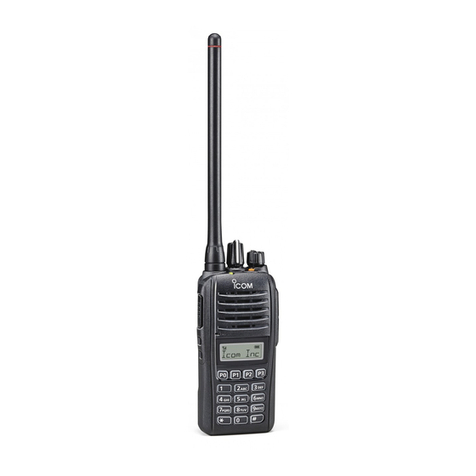
Icom
Icom IC-F1000 series User manual
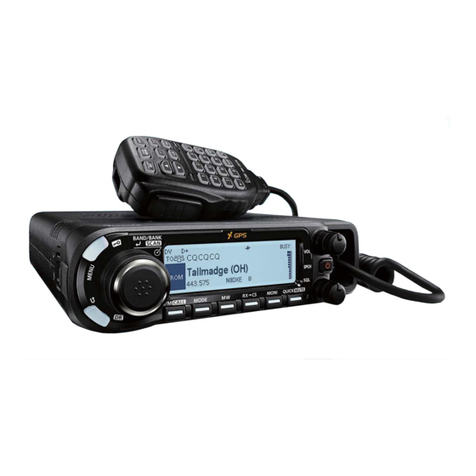
Icom
Icom D-STAR ID-4100A User manual

Icom
Icom IC-M1 euro User manual

Icom
Icom IC-3220A User manual
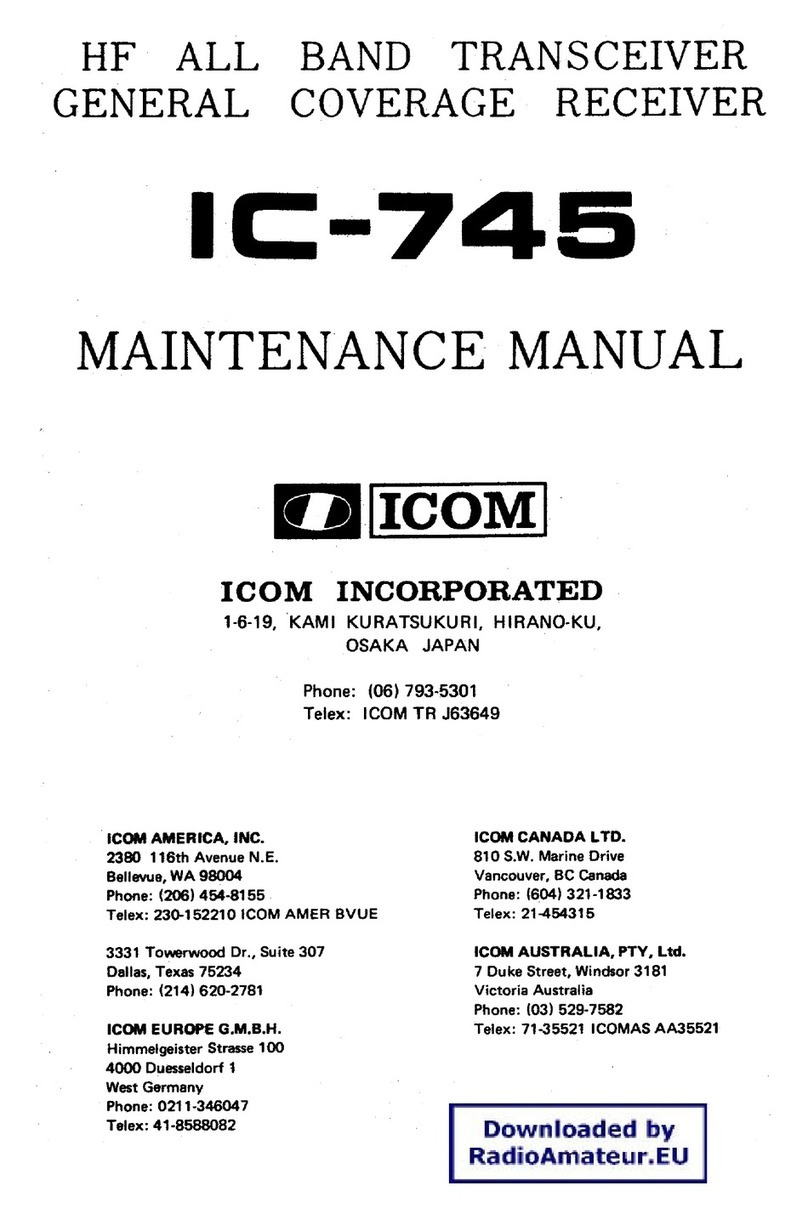
Icom
Icom IC-745 User manual
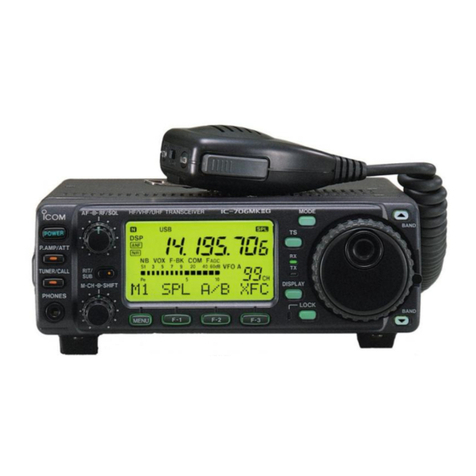
Icom
Icom IC-706MKIIG User manual

Icom
Icom IC-706 User manual

Icom
Icom IC-F40GT User manual

Icom
Icom IC-2720 User manual
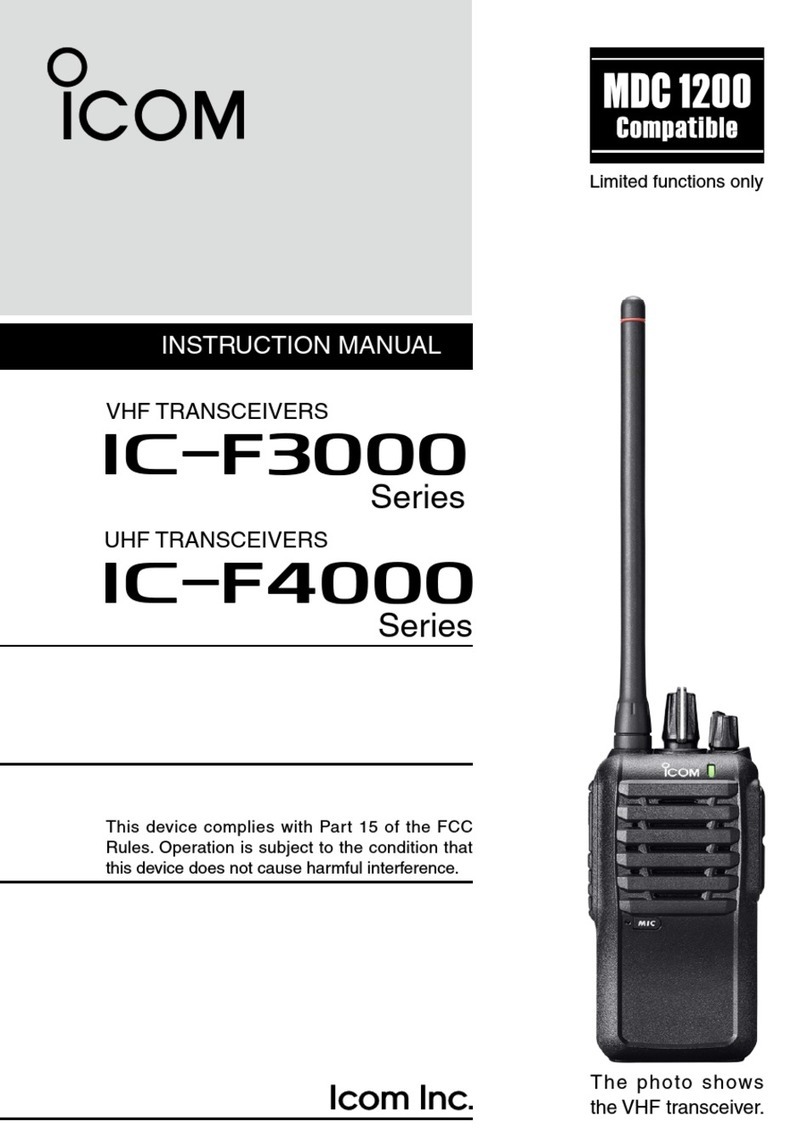
Icom
Icom IC-F3000 Series User manual
